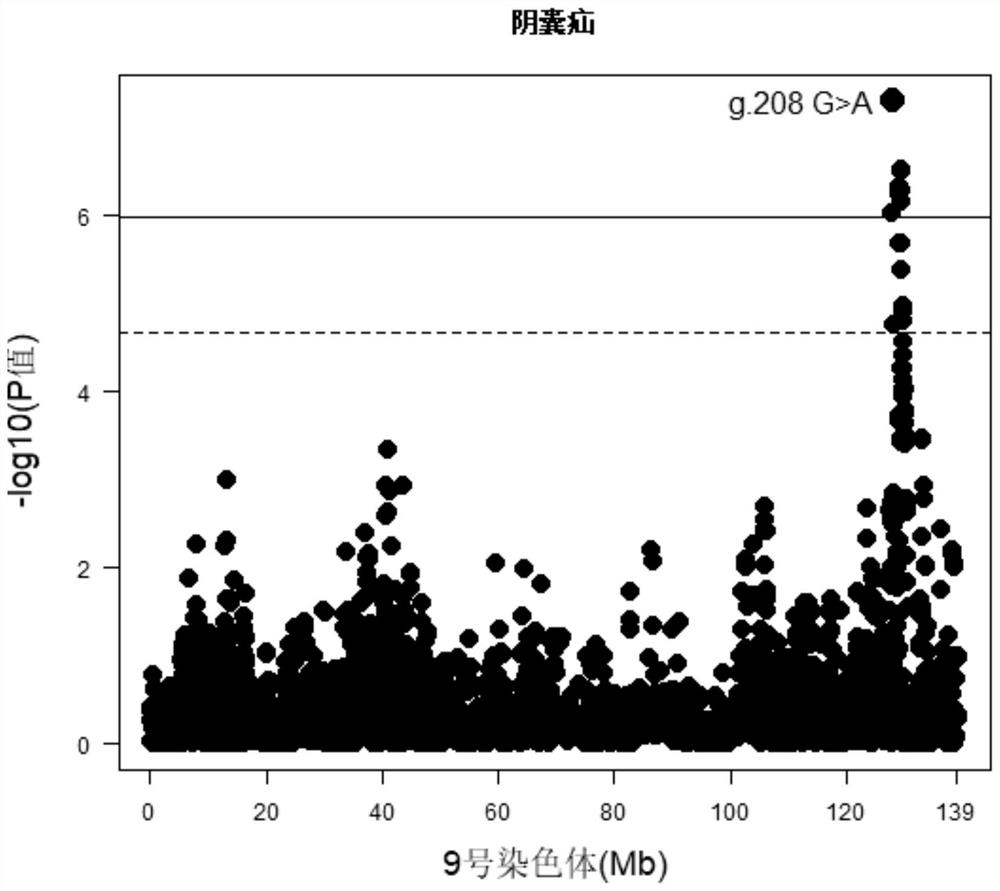SNP molecular marker located on pig chromosome 9 and related to scrotal hernia and application
A technology of molecular markers and scrotal hernia, applied in the fields of molecular biotechnology and molecular markers, can solve problems such as large confidence intervals, complex genetic mechanisms, and inability to accurately anchor disease-causing genes
- Summary
- Abstract
- Description
- Claims
- Application Information
AI Technical Summary
Problems solved by technology
Method used
Image
Examples
Embodiment 1
[0040] (1) Experimental animals
[0041] The experimental pig group used in the present invention is 1099 purebred Landrace pigs from the Breeding Pig Branch of Wen's Food Group Co., Ltd., which is the core group of the Breeding Pig Branch.
[0042] In this experiment, the Landrace pigs in this resource group were selected. The pigs have free access to food and water, and the entire feeding method and feeding conditions are always consistent, which is a conventional method.
[0043] (2) Sample collection
[0044] The above-mentioned piglet docked tail and ear tissues were collected and soaked in ethanol solution with a volume fraction of 75%, and stored in a -20°C refrigerator for later use.
[0045] (3) 50K SNP typing in the whole pig genome
[0046] From the ear tissue or docked tail tissue collected from each individual of 1047 Landrace pigs selected from the above resource groups, the whole genome DNA was extracted by the standard phenol-chloroform method, and each sampl...
Embodiment 2
[0058] Example 2 Target DNA sequence amplification and sequencing
[0059] (1) Primer design
[0060] The DNA sequence of SEQ ID NO: 1 on pig chromosome 9 was downloaded from the Ensembl website (http: / / asia.ensembl.org / index.html), and primers were designed using the primer design software primer premier 6.0. The DNA sequences of the designed primers are as follows:
[0061] P001-F: 5'-CTGGCTCCAGAGTGAGGAGA-3',
[0062] P002-R: 5'-GACACAACCCAAGAGGTCCA-3';
[0063] (2) PCR amplification
[0064] Add 1 μL of DNA template, 3.4 μL of double distilled water, 5 μL of 2×Tag PCR StanMix with Loading Dye, and 0.3 μL of primers P001-F and P002-R into a 10 μL reaction system. The PCR reaction conditions were as follows: 5 minutes of pre-denaturation at 94°C, 35 cycles of denaturation at 94°C for 30 s, annealing at 58°C for 30 s, extension at 72°C for 45 s, and finally 5 min at 72°C.
[0065] (3) DNA sequence determination
[0066] DNA sequence sequencing identification: carried out...
Embodiment 3
[0069] Example 3 SNP site g.208G>A effect analysis of molecular markers
[0070] According to Table 1, for the scrotum hernia of pigs, the frequency (AA) of the SNP site g.208G>A dominant allele is 0.167 in diseased individuals and 0.627 in normal pigs; the favorable allele The frequency of A was 0.33 in individuals with scrotal hernia and 0.79 in normal pig individuals. Therefore, through molecular marker-assisted selection and gradually eliminating pigs with genotype GG in the population, the allele frequency of allele A can be significantly increased, the incidence of scrotal hernia in breeding pigs can be reduced, and animal welfare can be improved while reducing breeding losses. , to speed up the improvement of genetic defects in pigs so as to effectively improve the economic benefits of pig breeding.
PUM
 Login to View More
Login to View More Abstract
Description
Claims
Application Information
 Login to View More
Login to View More - R&D
- Intellectual Property
- Life Sciences
- Materials
- Tech Scout
- Unparalleled Data Quality
- Higher Quality Content
- 60% Fewer Hallucinations
Browse by: Latest US Patents, China's latest patents, Technical Efficacy Thesaurus, Application Domain, Technology Topic, Popular Technical Reports.
© 2025 PatSnap. All rights reserved.Legal|Privacy policy|Modern Slavery Act Transparency Statement|Sitemap|About US| Contact US: help@patsnap.com



